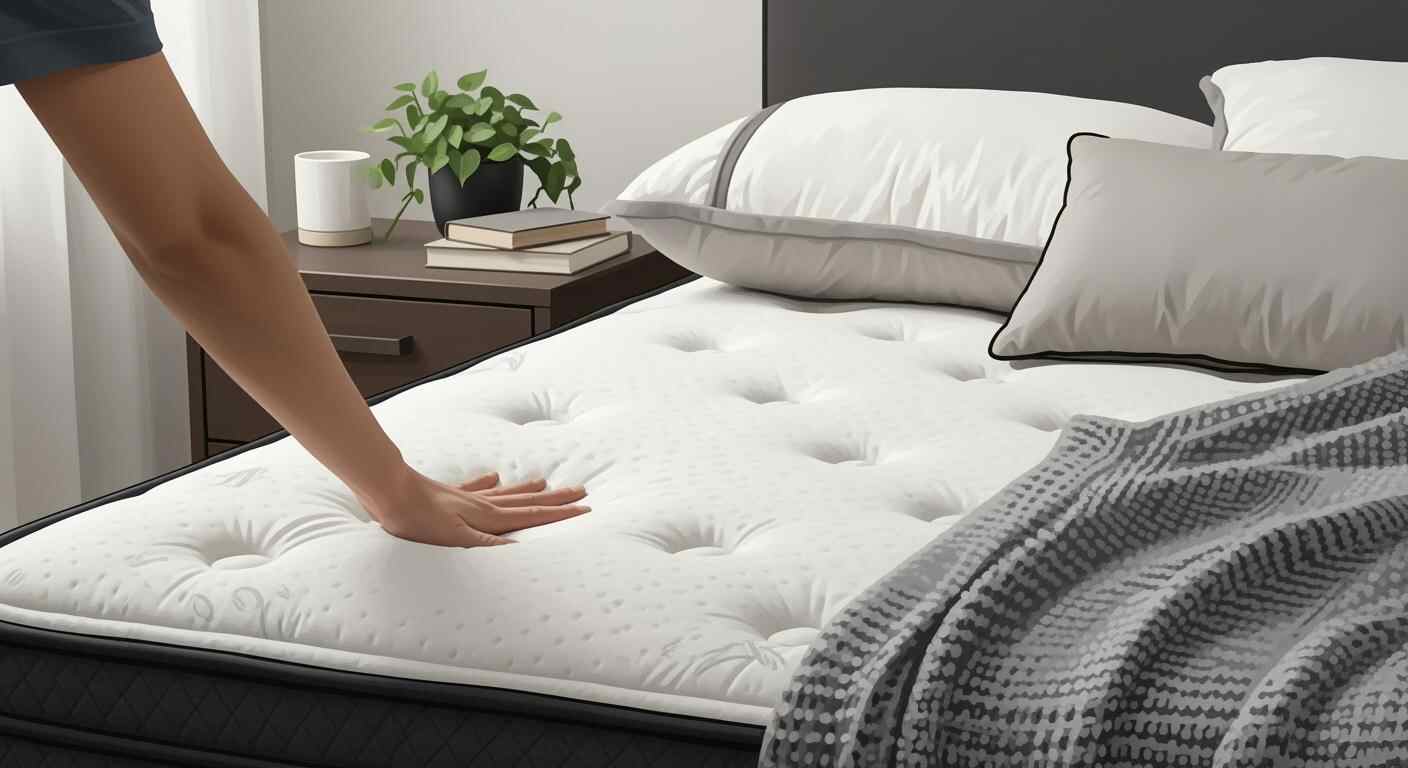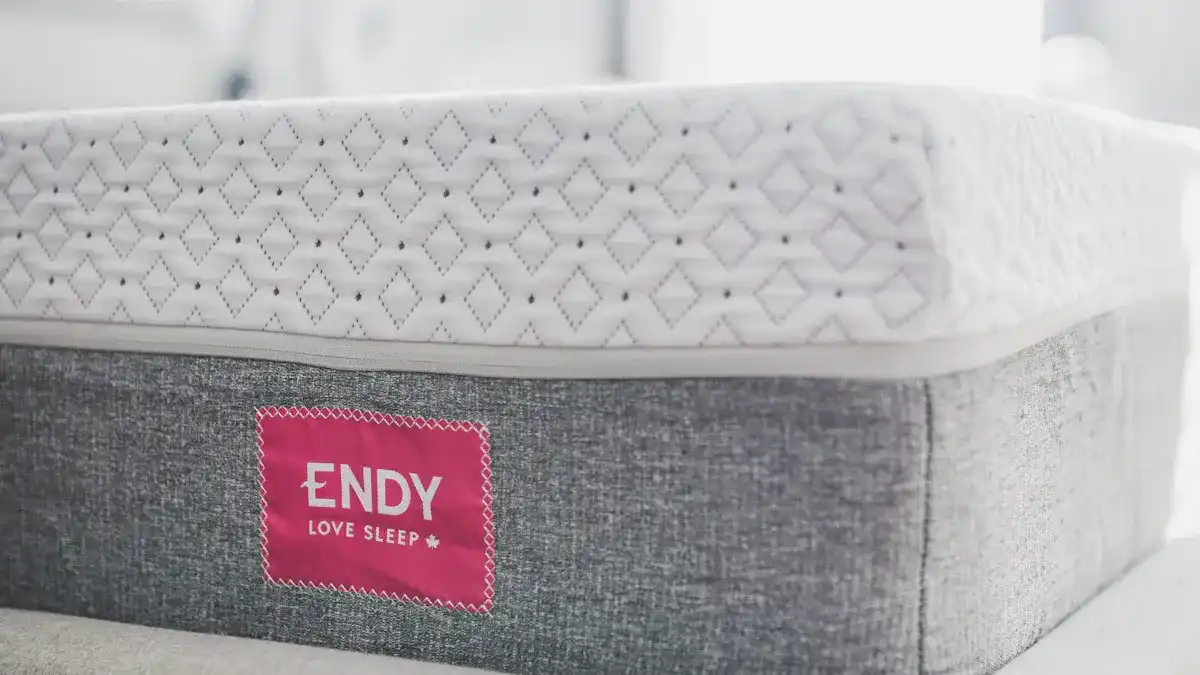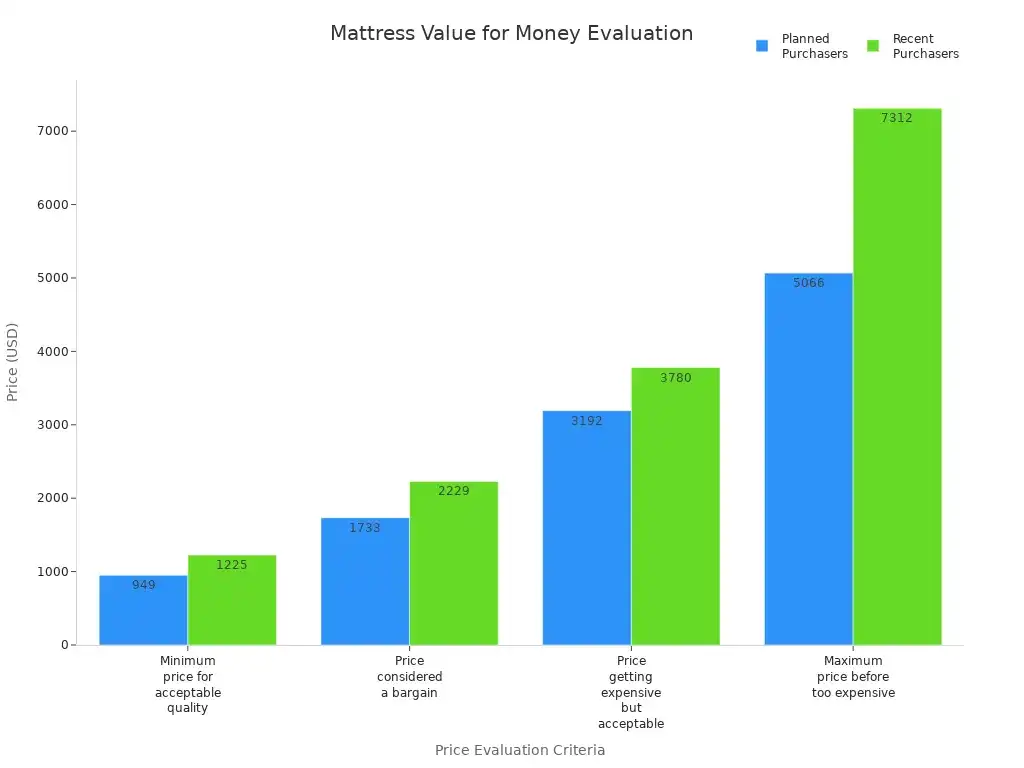Address
No.3 Chengcai Road, Leliu Town, Shunde District, Foshan City, Guangdong, China 528322
Address
No.3 Chengcai Road, Leliu Town, Shunde District, Foshan City, Guangdong, China 528322
Choose a quality bed mattress by matching firmness, materials, and support to your sleep needs for better rest and long-term comfort.


You deserve a good night’s sleep every day. Picking the right quality bed mattress makes a big difference for your health and comfort. Many adults say their sleeping feels better after switching to a supportive bed. You might notice less pain, better mood, and more energy. Studies show that mattress firmness can help you fall asleep faster and stay in deep sleep longer. If you want practical tips and real results, consider your comfort and personal needs.
People report better sleep, less stress, and improved mood after upgrading their mattress.
Research shows medium-firm mattresses boost sleep efficiency and total sleep time.
A good mattress helps you sleep better. It can lower pain and make you feel happier. Think about getting a new one for better health.
Pick the right firmness for how you sleep. If you sleep on your side, you need a softer bed. If you sleep on your back or stomach, you need a firmer bed.
Find materials that let air move through. This helps you stay cool at night. Gel-infused foam and latex are good for comfort and airflow.
Try out mattresses for at least 20 minutes before you buy. This makes sure the bed feels good and supports you well.
Look for warranties and trial periods. These help protect your money. You can also test the mattress at home.
When you shop for the best mattress, you want to know what makes a quality bed mattress stand out. You might notice that the sleep industry looks at several important criteria. Take a look at this table to see what experts say matters most:
Criteria | Description |
|---|---|
Consumer Recognition of Sleep Health | People now understand how sleep affects health and daily life. |
Technological Advancements in Materials | New materials like memory foam and cooling gels boost comfort and durability. |
Growth of Online Retailing | Shopping online makes finding the best mattress easier and often more affordable. |
Growth in Disposable Income | More people can invest in a quality bed mattress for better sleep. |
Aging Population and Health Issues | Older adults need mattresses that offer comfort and pressure relief for special health needs. |
You want a mattress that feels comfortable and supports your body. The best mattress uses high-quality materials and offers good breathability. You should look for a bed that fits your sleep style and helps you wake up refreshed. If you have allergies or sleep hot, you might want a mattress with cooling features or hypoallergenic covers.
You spend hours every night on your bed, so the quality of your mattress affects your health. A quality bed mattress can help you sleep better and feel less pain. Studies show that switching to a medium-firm mattress can lower back pain by almost half and improve sleep quality by over 50%. You might notice less pain and more comfort after just a few weeks.
Many people report less pain and better sleep after using the best mattress for their needs.
Medium-firm mattresses help your spine stay aligned and boost comfort.
You may feel more rested and ready for your day when you sleep on a quality bed.
Tip: Try lying on a mattress for at least 20 minutes before you buy. You want to make sure it feels comfortable and supports your body.
Choosing the right mattress can feel overwhelming, but you can make it simple by focusing on your needs. When you know how to choose a mattress, you set yourself up for better sleep and more energy every day. Let’s break down the steps so you can find a quality bed mattress that fits you perfectly.
Your sleeping position is the first thing you should think about. It affects how much support and comfort you need from your bed. Here’s how you can start:
Figure out if you sleep on your side, back, stomach, or a mix of these.
Think about any back or joint pain you have. Some positions need more support than others.
Notice if you toss and turn or stay in one spot all night.
Tip: Side sleeping is often best for your spine. It helps keep your back in a healthy shape and can lower pain, especially if you have back problems. Back sleeping can also work well if your mattress gives enough support. Try to avoid stomach sleeping because it can hurt your back over time.
The firmness of your mattress matters a lot. It decides how much your body sinks into the bed and how well your spine stays in line. If you want to know how to choose a mattress that supports you, check out this table:
Sleep Position | Description | |
|---|---|---|
Side Sleepers | 4–6 | Softer to medium-soft feel. Eases pressure on hips and shoulders. |
Back Sleepers | 6–7 | Medium-firm. Supports your lower back and keeps your spine straight. |
Stomach Sleepers | 7–8 | Firmer surface. Stops your hips from sinking and keeps your back flat. |
A quality bed mattress keeps your spine in its natural shape. If your mattress is too hard, your lower back might not touch the bed, which can make your back curve in a bad way. If it’s too soft, your hips can sink too much, which also hurts your back. The right firmness helps you wake up with less pain and more comfort.
You should also look at support ratings when you choose a mattress. Some brands offer high support, which is great if you need a mattress for back pain. Here’s a quick look at how support ratings can differ:
Mattress Model | Support Rating | |
|---|---|---|
Cloverlane Foam Luxury Firm mattress | 3 | N/A |
Firm Mattress A | 7 | High |
Firm Mattress B | 8 | High |
Firm Mattress C | 9 | Very High |
Note: Spend at least 20 minutes lying on any mattress you want to buy. Try different positions. This helps you feel if the bed gives you the comfort and support you need.
When you learn how to choose a mattress, you should also think about what it’s made of. The materials affect how cool you feel at night and how long your bed lasts. Some mattresses trap heat, while others help you stay cool and dry.
Here’s a table to help you compare common mattress materials:
Material | Properties |
|---|---|
Gel-Infused Memory Foam | Keeps you cool by using gel beads that pull heat away from your body. |
Latex | Natural and breathable. Lets air flow and helps you stay cool. |
Copper-Infused Memory Foam | Moves heat away and wicks away sweat. |
Ventilated Memory Foam | Has holes for airflow, so you don’t get too hot. |
Pocketed Coils | Springs that let air move through the bed, making it cooler. |
If you have allergies, you should look for hypoallergenic materials. These can help you breathe easier and wake up with less stuffy nose or itchy skin. Memory foam and wool are good choices because they keep out dust mites and mold. You can also use dust covers to block allergens.
When you choose a mattress, check for certifications like CertiPUR-US or OEKO-TEX. These show that the bed is safe and made without harmful chemicals. Durability is important too. A quality bed mattress should last for years without sagging or losing comfort.
Tip: Always ask about the materials and certifications before you buy. This helps you pick a mattress that is safe, cool, and comfortable for your sleeping needs.
If you follow these steps, you will know how to choose a mattress that gives you the best comfort and support. You will sleep better and wake up ready for your day.

When you shop for a new mattress, you see many choices. Each mattress type has its own feel, support, and features. Let’s look at the most popular mattress types so you can pick the best bed for your sleep.
Memory foam mattresses feel soft and hug your body. You sink in a little, and the bed shapes to you. Many people love the comfort and support. Couples like memory foam because it stops movement from waking each other up. Here’s a quick look at what users say:
Advantages | Disadvantages |
|---|---|
Amazing comfort | Can be expensive |
Excellent support | Can get hot |
Ideal for couples | Can be difficult to move |
Durable | Has a distinct smell |
Low maintenance | Cheaper models do not last as long |
Memory foam mattresses last about 6 to 7 years. They resist body impressions but may sag over time. If you want a cozy bed, memory foam is a good choice.
Innerspring mattresses use coils inside the bed. You get a bouncy feel and strong support. These mattresses stay cool because air moves through the coils. They work well if you like a firmer bed. Innerspring mattresses last about 5.5 to 6.5 years. They may sag faster than other mattress types, but they hold up well against body impressions.
Hybrid mattresses mix foam and coils. You get the comfort of foam and the support of springs. Many people like hybrids because they balance softness and firmness. Here’s what makes hybrid beds special:
Component | Description |
|---|---|
Coil Support System | Firm support and better airflow |
Comfort Layer | Shapes to your body and eases pressure |
Edge Support | Strong edges so you can use the whole bed |
Transition Layers | Extra cushioning for a smooth feel |
Hybrid mattresses last about 6.5 to 7.5 years. They resist sagging and give good support. If you want a bed that feels just right, hybrids are worth a look.
Tip: Hybrid mattresses help you stay cool and comfortable all night.
Latex mattresses use natural or synthetic latex. You get a springy feel and great airflow. Latex beds last the longest, about 7.5 to 8.5 years. They resist sagging and keep their shape well. If you want a durable mattress, latex is a smart pick.
Mattress Type | Durability Rating | Resistance to Sagging | Resistance to Developing Body Impressions | Overall Longevity Rating | |
|---|---|---|---|---|---|
Innerspring | 5.5 to 6.5 years | Poor to fair | Poor to fair | Good | Fair |
Foam | 6 to 7 years | Fair to good | Fair | Poor to fair | Good |
Latex | 7.5 to 8.5 years | Good to very good | Good | Fair to good | Very good |
Hybrid | 6.5 to 7.5 years | Fair to good | Fair | Good | Good |
When you know the differences between mattress types, you can choose the best bed for your sleep style and comfort.

You want a mattress that matches how you sleep and your body type. Your sleeping position changes the support you need. If you sleep on your side, you need a mattress that cushions your hips and shoulders. Back sleepers need a bed that keeps their spine straight. Stomach sleepers do best with a firmer mattress so their hips don’t sink. If you switch positions, look for a mattress that responds quickly to movement.
Here’s a table to help you see what matters most:
Factor | Description |
|---|---|
Support Distribution | Helps with pressure points and support based on your weight. |
Comfort Preferences | Your personal feel for the mattress, no matter your body type. |
Durability Requirements | A strong mattress keeps support and comfort over time. |
Sleep Position | Side, back, or stomach sleeping changes what mattress you need. |
Body Type Considerations | Your weight and shape guide you to the right mattress firmness. |
Your weight also affects how a mattress feels. Heavier people sink in more, so the mattress feels softer. Lighter people may find the same bed firmer. Check this chart for firmness suggestions:
Body Weight | Suggested Firmness |
|---|---|
Lightweight (under 130 lb) | 6/10 |
Average (130 – 230 lb) | 6.5/10 |
Heavyweight (over 230 lb) | 7/10 |
Tip: Ask yourself, “How do I feel when I wake up? Do I need more support or comfort?” Your answers help you pick the best mattress.
If you get hot while sleeping, you need a mattress that stays cool. Some beds use gel foam, latex, or coils to help air move and keep you comfortable. If you have allergies, look for a mattress with hypoallergenic covers or materials like memory foam or wool. These keep dust mites and mold away.
Cooling mattresses help you sleep better and wake up refreshed.
Hypoallergenic beds protect you from sneezing and itchy skin.
If you need a mattress for a child, choose one with safe, breathable materials.
Note: Always check for certifications like CertiPUR-US. These show the mattress is safe for you and your family.
Picking the right mattress size makes your bedroom feel cozy and helps you sleep well. Measure your room before you buy a bed. Leave space to walk around and open doors. If you share your bed, a King mattress gives you more room to move. A Queen mattress works well for couples in smaller rooms. If you have pets or kids who join you, a bigger mattress helps everyone sleep better.
Use a floor plan or cutouts to see how the mattress fits.
Leave at least 24 inches of space on two sides of the bed.
If you need a mattress for a child, a Twin or Twin XL is a good choice. Taller kids may need a longer bed.
Tip: Think about your future needs. Will your child grow soon? Will you add new furniture? The right mattress size keeps your room comfortable and easy to use.
When you shop for a mattress, you want a good deal. Mattress prices are different for each type. Here is a table that shows the average price for some mattresses:
Mattress Type | Price |
|---|---|
Low Profile Memory Foam Mattress | $299.99 |
Memory Foam Mattress | $349.99 |
High Profile Memory Foam Mattress | $449.99 |
Most people care about comfort, support, and health when buying a mattress. Brand reputation and new features also matter to buyers. Here is a table that shows how people think about mattress value:
Price Evaluation Criteria | Planned Purchasers | Recent Purchasers |
|---|---|---|
Minimum price for acceptable quality | $949 | $1,225 |
Price considered a bargain | $1,733 | $2,229 |
Price that is getting expensive but acceptable | $3,192 | $3,780 |
Maximum price before considering it too expensive | $5,066 | $7,312 |

Try to find a mattress that is comfortable and worth the price. Do not buy the cheapest bed just to save money. Think about how long the mattress will last and how well you will sleep.
A good mattress should have a warranty and a trial period. Warranties cover problems and usually last for years. Many companies let you try the mattress at home for at least 100 nights. Some brands let you exchange or adjust the mattress if you do not like it.
Aspect | Standard Details |
|---|---|
Warranty | Usually covers defects; many are prorated over time. |
Trial Period | At least 100 nights is common. |
Comfort Guarantee | Some brands offer adjustments instead of returns. |
Tip: Always read the details before you buy. Some stores want you to use a mattress protector or pay for shipping if you return the mattress.
Return rules are different for each store. Mattress Warehouse lets you exchange your mattress once in 120 days. You must buy a protector and try the bed for 30 nights first. Custom Mattress Makers gives you a 100-night guarantee, but you pay for shipping if you send it back.
You can buy a mattress in a store or online. Both ways have good and bad points:
In-store: You can test the mattress, find special deals, and sometimes talk about the price. There are fewer choices in stores.
Online: You get more options, lower prices, and delivery to your home. You cannot try the mattress before you buy.
A good delivery team helps a lot. They keep your mattress safe and protect your home. They set up the bed and make everything easy.
Note: Fast and careful delivery means your mattress arrives safely. You can start sleeping better right away.
Choosing a quality mattress starts with knowing your sleep needs and testing options. Here’s how you can make the best choice:
Research mattress types and comfort levels.
Set your budget.
Test mattresses by lying down in your favorite positions, using your pillow, and trying it with your partner.
Trial periods let you experience comfort at home, while warranties protect your investment. When you invest in better sleep, you boost your health, reduce pain, and enjoy happier mornings.
Most mattresses last 6 to 8 years. You might notice sagging or less support after that. If you wake up sore or see lumps, it’s time for a new one.
Tip: Rotate your mattress every few months to help it last longer.
You want a medium-firm mattress for back pain. It keeps your spine straight and eases pressure. Memory foam and hybrid mattresses work well for most people.
Mattress Type | Support Level | Good for Back Pain? |
|---|---|---|
Memory Foam | High | Yes |
Hybrid | High | Yes |
Innerspring | Medium | Sometimes |
Yes, you can buy a mattress online. Many brands offer free shipping and trial periods. You get more choices and better prices. Always check reviews and return policies before you buy.
Read customer reviews
Look for trial periods
Check warranty details
Your sleep position and body weight help you choose firmness. Side sleepers like softer beds. Back and stomach sleepers need firmer support. Try different beds in-store or use trial periods at home.
Note: Use your favorite pillow when testing mattresses for the best feel.